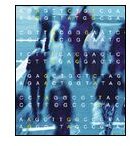What is genetic variation?
Genetic variation is the tool that enables us to all be different, and the mechanism by which a species evolves through time. It helps organisms to survive when the environment changes around them. For example if a new and potentially fatal disease threatens a population, be they plants, humans or animals, only those individuals that have genes for resistance to the disease will survive. If none are present, a population is faced with extinction.
Here we will look at 3 primary mechanisms by which genetic variation comes about; mutation, gene flow and sex.
Mutations
Mutations are changes in our basic DNA structure, the hereditary material of life. They are random events and can be harmful, neutral or beneficial.
Mutations can occur due to many physical and chemical reasons such as;
- Exposure to Harmful Rays: X-Rays, UV rays can instigate DNA to mutate
- High Temperature: High Temperature is also known for inducing mutations as DNA strands break in extreme heat
- Chemicals: Many chemicals can also lead to change in DNA structure which in turn produces mutations.
However, most mutations don’t matter to evolution; a change in the basic genetic structure inside any somatic cell (non-sex cell) will not be passed onto the next generation. Mutations only really matter in an evolutionary context if they happen in the sex cells, sperm and eggs, and are passed along the generations. Over time they can become fixed in the population. You can read more about DNA mutations by clicking here
Gene flow
Gene flow is best described as the influx of genetic change into an area or population where it did not previously exist. An obvious example of where new genes can be introduced into an area is with movement of people from one city or country to another.
How gene flow creates variation
Gene flow changes the frequency of particular allele in the population, which in turn changes the percentage of organisms having the trait. It leads to greater variation.
For example, if a person with red hair went to live with a tribe that had no such colouring and ended up marrying a local, there’s a chance that future generations may inherit this genetic variation. From a starting point of one person with red hair the numbers could well increase over time as the red hair gene is passed down the generations.
Sex and evolution
Sex, essential to reproduction of a species, is a major cause of genetic variation. Sex introduces new combinations of genes. This is why you and your brothers and sisters will not necessarily look identical.
How sex creates variation
The first opportunity for change and variation to take place is during the cell division process called meiosis that leads to the production of either sperm or eggs. Let’s take the creation of the egg for example. During cell division and the movement of chromosomes, there is an exchange of DNA in a process known as recombination. So already some of the genes here will be different from the mother. In other words variation. The same process goes on in the male. Then the major genetic shuffling happens when sperm and egg unite and two half genomes become one unique individual with a unique combination of genes.
It doesn’t stop
These processes of variation do not stop, they continue right through the ages; a never ending supply of differences as the past meets the present on their way to the future.
Credits
Photo Credits:
Photo #1: https://www.genome.gov/25520487
